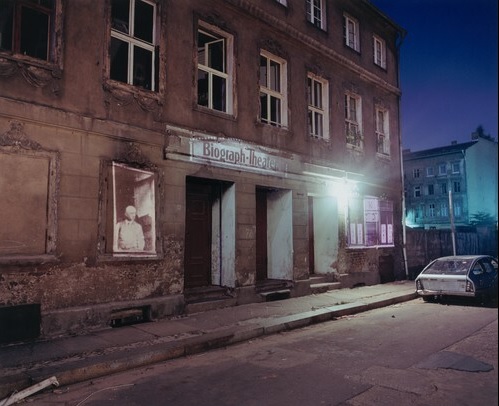
Shimon Attie
American, 1957-
Joachimstrasse 20, Berlin, 1991
chromogenic print
27 x 33 in.
SBMA, Museum purchase with funds provided by Morris B. Squire
2001.18.4

Shimon Attie, St. Louis Post-Dispatch, 2019
“For The Writing on the Wall project, I slide projected portions of pre-world war II photographs of Jewish street life in Berlin onto the same or nearby addresses where the photos were originally taken 60 years earlier. By using slide projection on location, fragments of the past were thus introduced into the visual field of the present. Thus parts of long destroyed Jewish community life were visually simulated, momentarily recreated. The projections were visible to street traffic, neighborhood residents, and passersby. As much of my art practice is a marriage between photography and installation art, during the course of the installations, I photographed the projections. The Writing on the Wall project was realized in one of Berlin’s former Jewish quarters, the Scheunenviertel, located in the Eastern part of the city, close to the Alexanderplatz.”
http://shimonattie.net/portfolio/the-writing-on-the-wall/
COMMENTS
The splashy colors and tricky lighting of Shimon Attie's photography act as an internal advertisement for their somber memorial intent, billed as somehow different from run-of-the-mill Holocaust nostalgia. In 1991, the 38-year-old American artist moved from Northern California to Germany, where he was dismayed to find that all traces of the country's Jewish past had disappeared. In response, Attie began projecting archival photographic images of pre-World War Two German Jewry on the walls of the often still-extant buildings depicted in the original photos. In his 1994 series "The Writing on the Wall", these buildings are located in the old Jewish quarter of Berlin - better known, until recently, as East Berlin.
Most of the black and white projections depict shops, shopkeepers and the occasional pedestrian. But Attie's documentary photographs of his projections, which he considers the primary artistic product of his endeavors, aren't quite what one would expect from such a historically grounded project. They are large, deeply saturated color prints, in which the artist has made conspicuous use of colorful backlighting seen most often in ads for youth-culture clothing.
Attie's tableaux are peppered by melodramatic, almost cinematic touches: in Joachimstrasse/Ecke Augustrasse, Berlin (1994), a (projected) man peers down from a group of tall windows to the deserted sidewalk below, while a (real) window to his left exudes a deep purple glow. Across the street, another building's windowpanes are transformed by the camera's lens into towering columns of white crosses, rising ominously into an inky sky. In Joachimstrasse 20, Berlin (1994), the ghostly marquee of a long-gone theater is bathed in a blue light which floods out from a neighboring alley, while a trashed, but carefully lit, Citroen squats meaningfully in the foreground. In other pieces, Attie has juxtaposed his Jewish actors and their establishments against modern graffiti alluding to World War Two and more recent German ethnic animosities. Wrapped tightly around their masonry supports, Attie's projections manage an effect that computer super-impositions never quite achieve: the organic feel of two mediums fused into one.
His working method is a smoother version of Krzysztof Wodiczko's, who similarly projected Nazi symbols on edifices in the 80s. Of course, the stakes have changed: whereas Wodiczko's artworks were unabashedly political, Attie's are couched in the language of healing and remembrance - fitting sentiments in this year of 50th anniversaries. But all of these birthday celebrations - marking the 50th anniversary of D-Day, of Pearl Harbor, of Bergen-Belsen - aren't really about commemorating a half-century's milestone, but rather about remembering World War Two and its attendant atrocities before they officially fade into the abstract past. Ceremonies have been organized and monuments erected in the furious hope that this time (unlike countless tributes to countless earlier conflicts) they will stave off the loss of first-hand memory. Such commemorations, including Attie's own, arise from a belief in the mythical power of visual images to heal sufferers of past wrongs, or to resurrect the disappeared in order to remind today's despots of the lessons of history. But images don't contain any enduring kernel of truth or memory; they are, instead, convenient excuses for our forgetting. This is why Maya Lin's Vietnam Veterans Memorial is so uniquely successful: when people think of the Vietnam War, they aren't allowed to think of Lin's monument - thereby forcing the event to live on in the minds of those it affected, and to die with them. ...
https://www.frieze.com/article/shimon-attie
SBMA CURATORIAL LABELS
These two photographs belong to Shimon Attie’s "Writing on the Wall" series that the artist created in Berlin’s Scheunenviertel (“Barn Quarter”). Once home to a vibrant Jewish community, this centuries-old area and its inhabitants were decimated by the terror of the Nazi regime. Working at night, Attie projected images of Jewish life before World War II onto the area’s aged, yet still standing buildings. Taking its title from the biblical episode of Belshazzar’s Feast in the Book of Daniel, Attie’s series suggests a current precarious state of historical Recollection, in which those who were violently and ineradicably disappeared remain but dimly remembered.
- The Lens of Architecture, 2022
